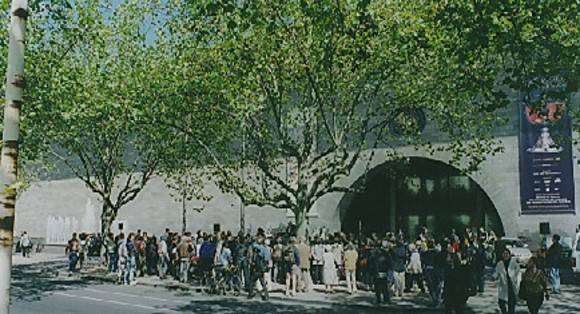| Back to search results » | Back to search page » |
|
National Gallery Of Victoria
Location144 - 198 St Kilda Road,, SOUTHBANK VIC 3006 - Property No B6582
File NumberB6582LevelState |
|
Statement of Significance
Statement of Significance. The National Gallery of Victoria, designed by noted architect Roy Grounds & Company Pty Ltd in 1961 and completed in 1968, is historically, architecturally and socially of State significance because:
(i) it was the first major public building in Victoria for nearly 50 years, and was the first entirely new Art Gallery to be constructed in Australia in the post-war period
(ii) the architectural expression is unique for its period, combining a modernist approach with various "Romantic" elements, especially the fortress-like exterior, dominated by bluestone cladding, and relieved only by a highlight window and a single arched entrance, the surrounding moat, the water wall, and the Great Hall with its Leonard French designed coloured glass ceiling
(iii) it is the major work by noted architect Roy Grounds (later Sir Roy), who, with his former partners Robin Boyd and Frederick Romberg, had been one of the most influential architects of his generation, pioneering modernist design. His predilection for simple geometric designs is reflected in the massive rectangular box-form of the main gallery, punctuated by square courtyards, and juxtaposed with the triangular former School of Art, and the circular spire (not built to its original design)
(iv) the layout involving three courtyards, (individually themed as oriental garden, sculpture court, and performance space), designed to provide visual relief, and multiple circulation choices around the building, was innovative
(v) the detailing of the interiors, often with a warm, almost domestic quality, is excellent
(vi) the display cases, designed by Grant and Mary Featherstone, are notable designs in their own right
(vii) the controversy at the time over the design within the architectural profession generated more comment than any other building since WW11
(viii) the design of the Gallery and Cultural Centre, especially the proposed copper-clad spire, represented a new era in the arts and public architecture, and greatly appealed to the general public and community leaders. Images of the spire were used to encourage public donations towards the construction costs.
Over the ensuing decades, with the construction of the adjacent Theatres building and Concert Hall, the site has become the primary focus for the arts in Victoria.
Classified: 01/04/1996
Group
Recreation and Entertainment
Category
Art Gallery/ Museum




